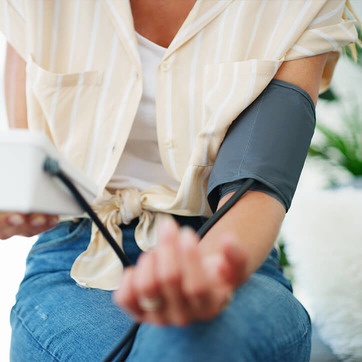
The force per area or the pressure of the blood on the vessel walls of veins, arteries and capillaries triggered by the heartbeat is referred to as blood pressure. But only the pressure in the major arteries is meant with the term “blood pressure” in everyday language use.
The task of blood pressure is to ensure blood circulation in the entire organism in order to supply it with sufficient oxygen and nutrients. A healthy body dynamically regulates the blood pressure, i.e. if required by means of increased cardiac output as well as by contraction or expansion of blood vessels (resistance vessels).
The pressure of blood is measured roughly at the level of the heart and is expressed in mmHg (millimetres of mercury) or in kPa (kilopascal).
At rest the heart beats about 70 times per minute; in the process, the cardiac muscle contracts and then relaxes again. During the heart’s phase of contraction (systole) the ventricles contract and pump the blood from the heart via the aorta into the pulmonary and systemic circulation. The blood pressure is highest when the heart has contracted strongest. This value is referred to as systolic blood pressure.
During the heart’s phase of relaxation (diastole) the ventricles widen again and once again fill with blood. No blood is pumped into the pulmonary and systemic circulation during this phase. The blood pressure decreases as a result. The lowest level of pressure is referred to as diastolic blood pressure.
That is why 2 levels are always indicated during a blood pressure measurement, for example with 120/80 mmHg (literally: “120 to 80”). The first level indicates the systolic blood pressure, and the second level indicates the diastolic blood pressure.
Physiological (“normal”) blood pressure levels are 120/80 mmHg. Factors such as age, sex and physical condition influence these levels. If levels are constantly above 150/90 mmHg during a blood pressure measurement, this is referred to as high blood pressure (hypertension).
Low blood pressure exists when the levels are below 100/60 mmHg among women and below105 mmHg/65 mmHg among men.
Blood pressure measurement is an important diagnostic tool to detect health impairments of cardiovascular functions in a timely manner.
Classification of blood pressure levels - blood pressure chart
Blood pressure levels are also age-dependent. They are lower in younger years than in old age. For instance, infants have a normal blood pressure at 85/65 mmHg, 6-year-olds at 95/60 mmHg and 14-year-olds at roughly 110/70 mmHg.
Blood pressure of 120/80 is considered optimal among adults, levels below 105/65 are regarded as low blood pressure (hypotension) and levels which exceed 140/90 are classified as high blood pressure (hypertension). The following chart helps to assess blood pressure.
Blood pressure table
Natural blood pressure fluctuations
Our blood pressure is actually not always constant, but adapts to the circumstances in the course of the day. Age, sex and time of day are factors which we cannot influence. But nutrition, body weight, physical and psychological burdens or certain medications also make the blood pressure fluctuate.
Physical or psychological burdens make the blood pressure levels increase, whereas in quiet phases of the day the blood pressure decreases so that the heart can recover again. Blood pressure fluctuations are therefore usually a natural adaptation of the body to daily demands, and quickly level off again among healthy people.
In the event of abnormal blood pressure fluctuations it can make sense to measure the blood pressure at different times of day or to perform a 24-hour measurement.
High blood pressure (arterial hypertension)
Chronic high blood pressure (arterial hypertension) is a disease of the cardiovascular system and is among the main risk factors of arteriosclerosis, and consequently a risk factor for heart attack and stroke.
The heart, brain, kidneys and eyes can particularly suffer from a permanent pressure load on the arteries. Arterial hypertension should always be medically monitored, and if a healthy lifestyle is not enough to reduce the blood pressure, medicinal treatment should possible be provided.
According to international definition, stage 1 hypertension exists if the levels are permanently above 140/90 mmHg. Levels above 180/110 mmHg are regarded as severe hypertension.
According to estimates provided by the German Hypertension League (Deutsche Hochdruckliga), about 35 million people suffer from high blood pressure – many without even knowing it, because high blood pressure does not cause any pain.
No clear cause exists among a majority of patients, because primary high blood pressure is addressed. Secondary high blood pressure – which forms due to a clear underlying disease such as the kidneys or the endocrine system – is rare. Then the primary objective is to treat this underlying disease.
Medications such as appetite suppressants, nonsteroidal anti-inflammatory drugs (e.g. diclofenac) or the birth control pill can also have a blood pressure increase as a side effect. Risk factors for hypertension can also be overweight, lack of exercise, smoking, alcohol consumption or stress.
Antihypertensive agents – beta blockers, ACE inhibitors and other drugs
In some cases a healthy lifestyle is also not enough to prevent or to lower an elevated blood pressure. A large number of medications such as beta blockers, diuretics or ACE inhibitors are available for treatment in case of critically elevated high blood pressure.
Which antihypertensive agents will be prescribed is to be individually determined by a doctor, because the drug class depends on pre-existing conditions and the blood pressure level.
Antihypertensive agents cannot cure hypertension, but merely reduce it within certain limits.

Low blood pressure (hypotension)
Low blood pressure is referred to if the measured level is below 100/60 mmHg among women and below 110/70 among men.
With low blood pressure, not enough blood is pumped from the heart in proportion to the width of the blood vessel. Consequently it can happen that the blood pressure is no longer sufficient to supply the brain with blood or oxygen. Particularly with long periods of standing or standing up quickly it can then lead to attacks of sweating, vertigo or sudden blackout.
Dangerous sequelae are not anticipated with hypotension, as is the case with hypertension, but typical symptoms such as vertigo, fatigue, lack of concentration, visual snow, tinnitus or even fainting can be dangerous and have a restrictive effect.
In principle, administration of medication is not necessarily required in the event of hypotension, unless the accompanying symptoms are too severe. Many of those individuals affected are even helped with simple behavioural rules such as hot & cold contrast showers in the morning, getting up slowly or drinking coffee or tea.
But anyone who suffers from low blood pressure should still consult a doctor in order to exclude illnesses in need of treatment as a cause.
Low blood pressure can be congenital, but also be caused by stress or overloading the nerve cells. Adolescents and very slender women are quite often affected.